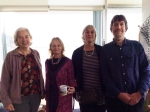When I was travelling the world as Chief Executive of a couple of literature and literacy NGOs in the 1990s, I very much enjoyed the time I spent in the Pacific islands of Samoa, Vanuatu, Fiji and the Solomon Islands. I therefore leapt at the opportunity this winter to visit Tahiti on our way to New Zealand, and cruise round the Society Islands on the good ship, Paul Gauguin. We normally spend our holidays in our little camper van, so this luxurious cruise was a fantastic treat.
We started in Tahiti, and over the course of the following ten days, called at seven other idyllic islands, five of which were in the Society Islands and the other two are atolls of the Tuamotu archipelago.
Tahiti has been inhabited since pre-historic times. It was discovered first by the British explorers Samuel Wallis (in 1767) and James Cook (in 1773); and then by the French explorer, Louis-Antoine Bougainville in 1773. Owned by Britain for over 100 years, it then became French in 1880, and in 1950 voted to remain under France rather than choosing independence.
The work of two of my favourite artists, Paul Gauguin and Henri Matisse, was influenced in one way or another by the time they spent in Tahiti. I had therefore hoped to visit the Gauguin museum, but it was closed for restoration two years ago, and no one seems to have any idea when it will reopen. I spent an interesting morning at the Museum of Tahiti and the Isles, but unfortunately they have not seen fit to exhibit any Gauguin material in the absence of the specialist museum.
Gauguin’s paintings of Tahiti are all well-known, and none more so than ‘Women of Tahiti on the Beach’.
In 1930, Matisse also visited Tahiti, and at the time claimed not to have been very affected by his visit there. However, towards the end of his life his mind appears to have returned to the light of this area, and in particular the designs used by the Tahitians in the cloth they print for their clothes, which bear some quite striking similarities to Matisse’s wonderful late ‘cut outs’.
The Society Islands were most probably named in honour of the Royal Society in London, though some believe they were named after the London Missionary Society, whose missionaries took Christianity to the islands.
Here are some very short notes on the other islands we visited, followed by a few general observations.
Huahine
There are two islands here: Huahine Nui (big) and Huahine Iti (small). There are some archaeological remains of maraes on the island, and a collection of famous blue-eyed eels, but we decided to catch the (fairly basic) local ‘bus (Le truck) in order to have a quick look around the tiny town before striking out along the beach to sink gratefully into the sea.
We spent two days in this Paradise. On the first day we took the tender to a private Motu (island beach) where I braved the heat on my first paddle board expedition, and also met a large and very beautiful stingray, which floated gracefully below me as I swam. The next day we went snorkelling in a coral garden known, with good reason, as The Aquarium.
Rangiroa and Fakarava
We had opted for the longer, ten day cruise, rather than the six-day one, and the extra part came next, as we sailed from the Society Islands to the Tuamotus Islands to visit the atolls of Rangiroa and Fakarava. In the Society Islands the islands are in lagoons, surrounded by coral reefs. The lagoons are a beautiful turquoise colour, laced by the white surf breaking on the coral reef. In the Tuamotus, we were visiting atolls, in which the coral reef surrounds a lagoon, with no island in the middle. Instead, the islands are part of the reef itself.
The lagoons were far larger than I had expected, covering many miles. Rangiroa is the largest atoll in Polynesia, and the second largest in world. It is 78 km long and 225km around, and contains 78 islands around a turquoise lagoon teeming with exotic fish.
Fakarava
was the ancient capital of the Tuamotu Archipelago, and the old village of Tetamanu has one of the first Polynesian Roman Catholic Churches, built of coral in 1874. The whole atoll is now protected as part of the UNESCO biosphere.
We were by now many miles from the Society Islands, so had a 36 hour sea passage to return to the main archipelago. It was good to be out of sight of land for so long, to experience a little of the vastness of the Pacific Ocean.
Taha’a
Possibly the most exotic day of our exotic holiday. We were dropped on a private island Motu on the atoll, where we were treated royally. We spent the day as ‘lotus eaters’, swimming, snorkelling, kayaking and partaking of the lavish barbecue.
Moorea
Our final port of call was the beautiful island of Moorea, where we spent two days. As with all the other islands, we moored a little way from the island and disemarked by tender. There are two deep bays, Opunohu Bay, where we moored, and Cook’s Bay.
Moorea is only seventeen miles from Tahiti, and we had looked out at its dramatic mountains in the distance on our first few days in Tahiti. After Tahiti, it is the most populated island. It is the remains of a volcano, and the outer rim of the crater is very evident in the sharp mountains that encircle the whole island.
As we were nearing the end of the holiday, we splashed out on two expeditions: an afternoon on a jet ski on the first day – which involved driving over water at 64 knots – and a ‘bus tour of the island on the second.
After ten days of utter peace and beauty, we returned to Pape’ete, which appeared very busy in contrast.
General observations
 Our ship, the Paul Gauguin, was extremely luxurious, and we were looked after very well. The vast majority of passengers were large North Americans, which was something of an education. I can now recognise women who have had a facelift; and I have sat at table with men who believe that the most important freedom, which they must retain at all costs, is the freedom to own guns. Being light drinkers and moderate vegetarian eaters, we probably didn’t get as good value from the deal as many of our fellow passengers – but we had a wonderful, relaxing time. There was a swimming pool on top deck, for extra swims between our sea immersions.
Our ship, the Paul Gauguin, was extremely luxurious, and we were looked after very well. The vast majority of passengers were large North Americans, which was something of an education. I can now recognise women who have had a facelift; and I have sat at table with men who believe that the most important freedom, which they must retain at all costs, is the freedom to own guns. Being light drinkers and moderate vegetarian eaters, we probably didn’t get as good value from the deal as many of our fellow passengers – but we had a wonderful, relaxing time. There was a swimming pool on top deck, for extra swims between our sea immersions.
One huge concern to me was the number of plastic bottles of water that were consumed. Some sea water was desalinated, but the heat is intense and it really is necessary to consume a great deal of drinking water. We all know about the huge area of the Pacific that is now polluted by a raft of plastic, and everyone – tourists and locals alike – use several new plastic bottles every day. I don’t know what the answer is to this problem, though some new biodegradable materials are being developed. They cannot come too soon.
All the Polynesians we met were lovely people. Not only were they welcoming, friendly and happy, but in many cases displayed exceptional empathy, often intuiting what we were going to say before we opened our mouths.
Many of them are also ravishingly beautiful. We were treated to several Polynesian dance  shows. These sinuous dances were banned by the missionaries, who presumably found them a little too suggestive; and the dances began to be rediscovered/reclaimed only in the mid-20th century. It is, of course, impossible to tell how close they now are to the original dances.
shows. These sinuous dances were banned by the missionaries, who presumably found them a little too suggestive; and the dances began to be rediscovered/reclaimed only in the mid-20th century. It is, of course, impossible to tell how close they now are to the original dances.
The islands are all Francophone, and everyone speaks the local Tahitian language as well. As usual when travelling, it was worth learning a couple of words of the local language; but everywhere we went, people were surprised and delighted that we spoke French.
The economy of the islands is based on tourism, black pearls and vanilla.
The main garment for both women and men is still what in Samoa I knew as the lava lava and in India as the sarong, and in Polynesia is called the paleo. Most of the designs are bright and colourful, and there are dozens of interesting ways of tying it.
All the islands we visited were unbelievably beautiful, set in turquoise lagoons, surrounded by coral on which white spray breaks constantly to form a lacy border. The coral is of many different colours and shapes, and the number and variety of fish defy description. Other wild life was not so plentiful, though there were plenty of frigate birds fishing round the islands, and on Tahiti there were minahs, pretty little ground doves with budgerigar blue faces and fine striped feathers; and tiny, multicoloured finches.
Both air and water temperature were a constant 31-34 degrees, so we could swim and snorkel for hours, only leaving the water when we were completely soggy. It was also of the highest salt content that I’ve ever known, so it was so buoyant one could practically sit on it.
Having enjoyed the holiday of a lifetime, it’s back to the camper van for the next few years!
1 Comment











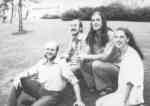 nald, a fantastic jazz saxophonist and flautist; the actor and musician, Gus Garside; poet and crystallographer Robin Shirley; and me. I was lecturing in Philosophy at Surrey University at the time, but was also a poet and musician. The biographical notes that appeared in the programmes for some of our performances are at the bottom of the page, below the sample poem.
nald, a fantastic jazz saxophonist and flautist; the actor and musician, Gus Garside; poet and crystallographer Robin Shirley; and me. I was lecturing in Philosophy at Surrey University at the time, but was also a poet and musician. The biographical notes that appeared in the programmes for some of our performances are at the bottom of the page, below the sample poem.
 hen came out, and for each phrase we had to determine what the probability was of its occurring, and the possibility we wished to allow for that phrase to be repeated. The skill, obviously, was in choosing the best phrases to feed in; and some of the results were strikingly good. The computer programme we used was devised by Robin using the ICL 1905F computer at the University of Surrey.
hen came out, and for each phrase we had to determine what the probability was of its occurring, and the possibility we wished to allow for that phrase to be repeated. The skill, obviously, was in choosing the best phrases to feed in; and some of the results were strikingly good. The computer programme we used was devised by Robin using the ICL 1905F computer at the University of Surrey.
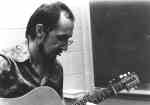

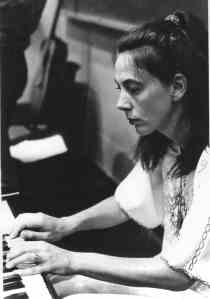 her works during our time together, including ‘Pavan for the Children of Deep Space’ and the extended group of poems in the popular suite ‘The Wheel of Seasons’. We then took all these works and jazz improvised to them, using sax, flute, guitar and bass guitar, keyboard, voice and various percussion instruments. It was all good fun.
her works during our time together, including ‘Pavan for the Children of Deep Space’ and the extended group of poems in the popular suite ‘The Wheel of Seasons’. We then took all these works and jazz improvised to them, using sax, flute, guitar and bass guitar, keyboard, voice and various percussion instruments. It was all good fun.







 I had an interesting three days this last week, with Everyman at the National Theatre neatly sandwiched between a gig in which I was to be found playing the cornet as I marched down Kingsbridge Fore Street accompanying the townspeople as they danced the Floral Dance, and an open air performance of The Taming of the Shrew by Guildford Shakespeare Company. A
I had an interesting three days this last week, with Everyman at the National Theatre neatly sandwiched between a gig in which I was to be found playing the cornet as I marched down Kingsbridge Fore Street accompanying the townspeople as they danced the Floral Dance, and an open air performance of The Taming of the Shrew by Guildford Shakespeare Company. A ll three were hugely enjoyable, but this blog is about the National Theatre production of ‘Everyman’ on the middle evening. The play is based on the mediaeval morality play, updated with a script written by Carol Ann Duffy.
ll three were hugely enjoyable, but this blog is about the National Theatre production of ‘Everyman’ on the middle evening. The play is based on the mediaeval morality play, updated with a script written by Carol Ann Duffy. reography, sound and visual effects, could have been cut a little: we really had got the message by half-way through the sequence; and occasionally we lost some vital words and therefore missed a joke or punchline. But all in all it was a wonderful evening, with fine dialogue, and exciting sound and visual effects, including a terrifyingly realistic tsunami.
reography, sound and visual effects, could have been cut a little: we really had got the message by half-way through the sequence; and occasionally we lost some vital words and therefore missed a joke or punchline. But all in all it was a wonderful evening, with fine dialogue, and exciting sound and visual effects, including a terrifyingly realistic tsunami. God (still sweeping and cleaning) is heard to comment on how she still loves him, which is a religious message if ever there was one. But apart from that, the splendour of the performance and the strong environmental message, the play reflects in the cast and the production the rich diversity both of London, and of life.
God (still sweeping and cleaning) is heard to comment on how she still loves him, which is a religious message if ever there was one. But apart from that, the splendour of the performance and the strong environmental message, the play reflects in the cast and the production the rich diversity both of London, and of life.

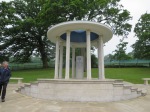
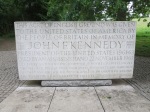 as designed by Sir Geoffrey Jellicoe. Part of the inspiration for his work is said to have been Bunyan’s Pilgrim’s Progress, and the experience of climbing up to the monument had a contemplative feeling. I found myself reflecting, sadly, not only on that crazy death, but on so many other areas of violence and killing in the world today.
as designed by Sir Geoffrey Jellicoe. Part of the inspiration for his work is said to have been Bunyan’s Pilgrim’s Progress, and the experience of climbing up to the monument had a contemplative feeling. I found myself reflecting, sadly, not only on that crazy death, but on so many other areas of violence and killing in the world today.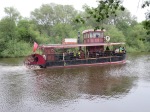
 Delamore House is on the edge of Dartmoor, and is of special interest to us because it used to be owned by the same family as lived in the house that now contains our apartment. Although it is considerably grander (our house was the family’s ‘summer house’), there were similarities and common features, including a tholos, or cromlech.
Delamore House is on the edge of Dartmoor, and is of special interest to us because it used to be owned by the same family as lived in the house that now contains our apartment. Although it is considerably grander (our house was the family’s ‘summer house’), there were similarities and common features, including a tholos, or cromlech. 



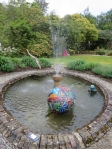
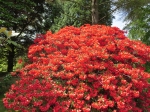




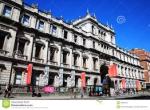



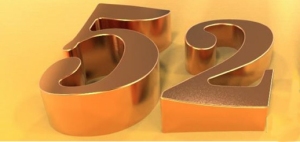
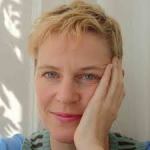
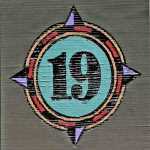


 d to miss the first day of the festival, so was not in Torquay for the dramatisation of Report from Judenplatz by Sue Boyle. I am told that the presentation by John Miles and his company was professional and moving; and having seen their Under Milkwood production later in the weekend, I can believe it.
d to miss the first day of the festival, so was not in Torquay for the dramatisation of Report from Judenplatz by Sue Boyle. I am told that the presentation by John Miles and his company was professional and moving; and having seen their Under Milkwood production later in the weekend, I can believe it.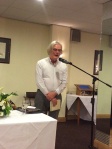
 ice Riordan, and a reading on the Sunday evening by Roger McGough. These were, not surprisingly, very different events, but both were hugely enjoyable, providing food for thought as well as wine and, in the case of the supper, good food. The poetry was good, of course; but other less poetry-related aspects of their performances were also appreciated: for instance, I had not heard Maurice read before and was charmed by his Irish accent; and Roger who was, as ever, extremely amusing, sported a pair of bright red shoes.
ice Riordan, and a reading on the Sunday evening by Roger McGough. These were, not surprisingly, very different events, but both were hugely enjoyable, providing food for thought as well as wine and, in the case of the supper, good food. The poetry was good, of course; but other less poetry-related aspects of their performances were also appreciated: for instance, I had not heard Maurice read before and was charmed by his Irish accent; and Roger who was, as ever, extremely amusing, sported a pair of bright red shoes. This year’s Torbay poetry competition was judged by R V Bailey, and at the prize-giving we were able to read the short-listed poems that were posted all round the walls, and give coloured dots to indicate where we would have awarded the prizes. The winner turned out to be Carole Bromley – a result that delighted me as I have been reading, and greatly enjoying, Carole’ poetry over the last few months.
This year’s Torbay poetry competition was judged by R V Bailey, and at the prize-giving we were able to read the short-listed poems that were posted all round the walls, and give coloured dots to indicate where we would have awarded the prizes. The winner turned out to be Carole Bromley – a result that delighted me as I have been reading, and greatly enjoying, Carole’ poetry over the last few months.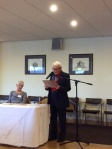 The other event that featured Rosie Bailey was a launch of the large anthology entitled ‘Love and Loss’ that she and June Hall have edited over the last year.
The other event that featured Rosie Bailey was a launch of the large anthology entitled ‘Love and Loss’ that she and June Hall have edited over the last year.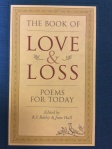
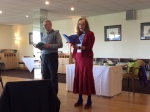



 I know the work practically word for word, I wondered whether this would be a disappointment. On the contrary, however, it was a wonderful performance, bringing out the music, humour and charm of the work.
I know the work practically word for word, I wondered whether this would be a disappointment. On the contrary, however, it was a wonderful performance, bringing out the music, humour and charm of the work.